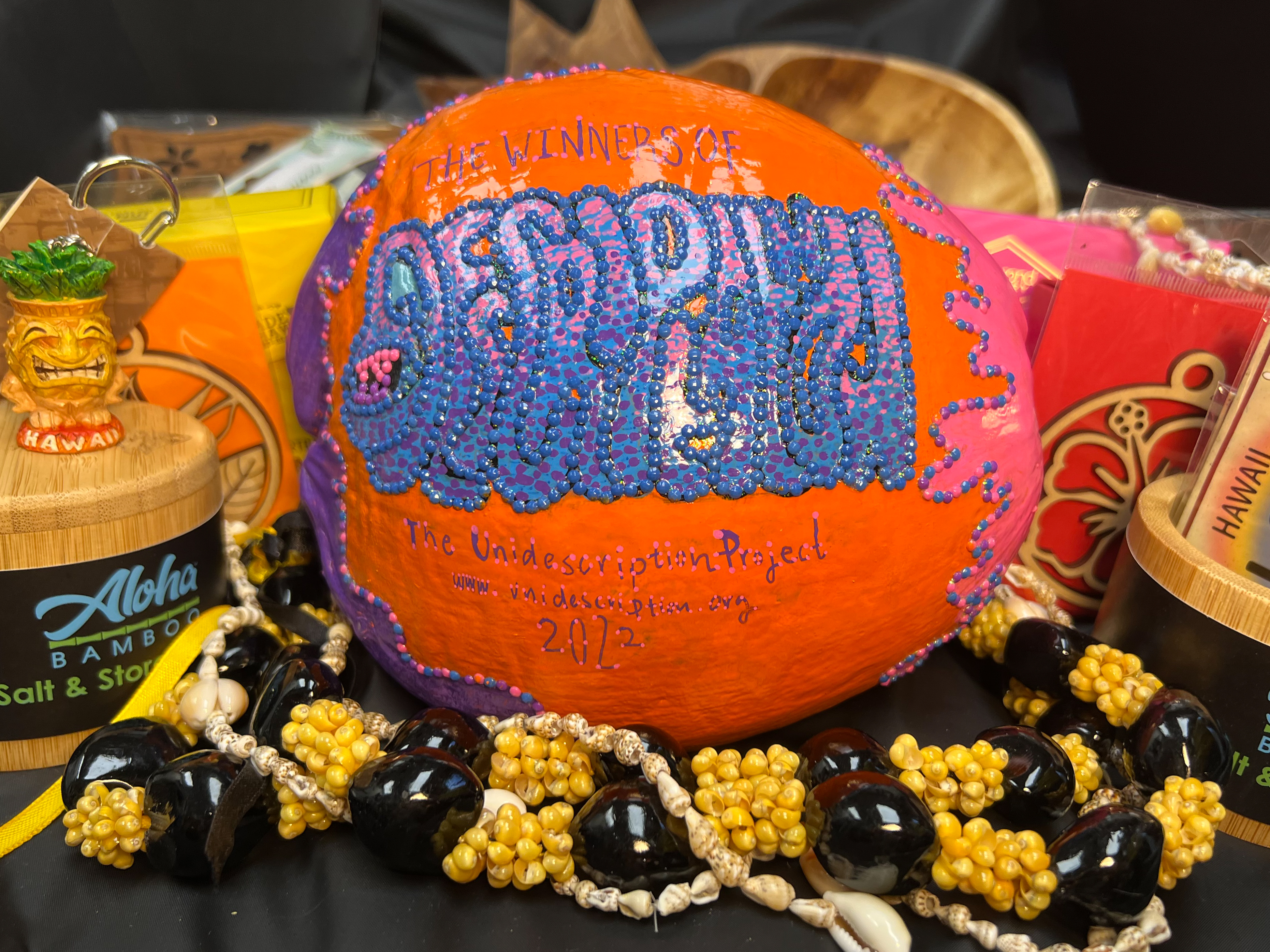- A gamified way to learn about Audio Description: What is Audio Description? Who uses it, and how? Why is it so important? How does it differ from other types of writing and communication? What are the best practices and top pro secrets? We use conference calls plus online tools and resources to create an engaging (and Covid-19 safe) learning environment that incorporates gameplay to investigate ideas about media accessibility, especially for people who are DeafBlind, blind, and low-vision.
- A fun way to practice Audio Description: We think people learn best — no matter what the topic — when they are motivated by interactions with others and having a good time in a social setting, even if that setting is virtual. Our training is tourney-style, featuring small teams and light-hearted competitions, peppered with Hawaii-oriented prizes. To be clear, as enjoyable and rewarding as it can be, the Descriptathon still is an intense three-day workshop that requires attention and dedicated engagement of all participants. We think if you’re going to commit to multiple days of learning about Audio Description, we are going to make it exciting and worth your while. Besides the three-day event, Descriptathoners also spend about 10 hours (2 hours a week for 5 weeks) prepping for the workshop. The outcomes, in turn, are concrete and impactful with each team producing an audio-described brochure made available to the public and team members taking these media-accessibility interests and skills with them for life.
- An efficient way to produce Audio Description: We don't just practice these Audio Description skills in cloistered safe spaces. We also make Audio Description for real contexts during this process, openly testing our ideas in public labs all over the country (and the world). In other words, we learn about and practice Audio Description in ways that make the world more accessible at the same time.
Want to take part in a Descriptathon? The UniDescription Project is a grant-funded research initiative, so there is no direct cost to the participants (other than their time engaged in the related activities). When we gather enough grant funds to support a Descriptathon, we put one on (and invite interested parties). That typically happens once or twice a year.
To sponsor a Descriptathon, we ask grant funders to provide $8,025 to support each team. Funders can support an individual team (or more). For example, at $32,100, a sponsor can support four teams; for $64,200, a sponsor can support eight teams; and so on. Each team usually has 5 to 10 people. Those teams include staff from the organizations we are working with — such as parks, museums, public attractions of any sort — and usually a couple of people who are DeafBlind, or blind, or who have low vision, and an external volunteer who is sighted and engaged in the description process. Throughout our time together we encourage active collaboration and co-creation of description.
If you don't have a sponsor, we also include teams from public places that are not able to directly contribute grant funds, but who eagerly want to participate. Our general Descriptathon funding model is to create openings at a 3:1 ratio, meaning, for example, once we have grant support for 12 teams, we host a 16-team Descriptathon that includes four teams from our open waiting list (if your site wants to get a team on that waiting list, just let us know via this email).
Grant funds not only support those additional teams, they also provide the core means for a variety of related research-and-development activities. These funds, for example, cover stipends for people who are DeafBlind, blind, or who have low-vision when they conduct extracurricular reviewing and judging tasks. They cover the costs of student research assistants who help with the project year-round; faculty contributors working during summers; and consultants from across disciplines. They help to cover basic costs of research, development, and dissemination. These grant funds are the reason we can offer all our software in open-source, open-access formats, which we maintain, refine, and update several times a year, at no cost to the producers and consumers of Audio Description. So, thank you, again, grant funders, including the U.S. National Park Service, Google, the National Endowment for the Humanities, and the National Endowment for the Arts!
If you would like to get involved in this project, either as a Descriptathon participant or as a funder, send an email of interest to the project's principal investigator, Brett Oppegaard, at this email.
And, on the individual level, here are some of the learner roles you can take in this project:




All of the coconut art was created by volunteer Tia Oppegaard
Descriptathon Championship Teams:
Descriptathon 11 (2025): Moores Creek National Battlefield (NPS Southeast Region)Descriptathon 10 (2024): Pinnacles National Park (NPS Pacific Region)
Descriptathon 9 (2022): Pullman National Monument (NPS Midwest Region)
Descriptathon 8 (2021): Fort Vancouver National Historic Site (NPS Pacific Region)
Descriptathon 7 (2021): Sleeping Bear Dunes National Lakeshore (NPS Midwest Region)
Descriptathon 6 (2020): Desert National Wildlife Refuge (USFWS)
Descriptathon 5 (2019): Frederick Law Olmsted NHS (NPS Northeast Region)
Descriptathon 4 (2019): Weir Farm National Historical Park (NPS Northeast Region)
Descriptathon 3 (2017): Whiskeytown–Shasta–Trinity NRA (NPS Pacific Region)
Descriptathon 2 (2017): Valley Forge National Historical Park (NPS Northeast Region)
Descriptathon 1 (2016): Not in a tourney format, so no champion crowned
Championships by Organization/Region
U.S. National Park Service (9) — Northeast (3), Pacific (3), Midwest (2), Southeast Region (1)
U.S. Fish & Wildlife Service (1) — West Region (1)










